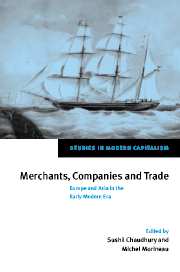Book contents
- Frontmatter
- Contents
- List of contributors
- Preface
- Introduction
- Part I Asia, especially India, around 1500
- 1 Of what world-system was pre-1500 ‘India’ a part?
- 2 Trade in the Indian Ocean at the dawn of the sixteenth century
- Part II Routes, markets and merchants
- Part III European presence in Asia
- Part IV Implications of trade: Asia and Europe
- Index
1 - Of what world-system was pre-1500 ‘India’ a part?
Published online by Cambridge University Press: 02 December 2009
- Frontmatter
- Contents
- List of contributors
- Preface
- Introduction
- Part I Asia, especially India, around 1500
- 1 Of what world-system was pre-1500 ‘India’ a part?
- 2 Trade in the Indian Ocean at the dawn of the sixteenth century
- Part II Routes, markets and merchants
- Part III European presence in Asia
- Part IV Implications of trade: Asia and Europe
- Index
Summary
The publication of the new Cambridge Economic History of India in 1982, and the subsequent, highly charged polemic between two of its editors, stimulated a fundamental reorientation of research agendas for Indian history. These volumes demonstrated that the growing compartmentalization of bodies of research and debate was accompanied by the rise of distinct historiographic traditions within each of these specialized bodies of literature, making it quite difficult to synthesize processes of long-term, large-scale social change within the subcontinent. Furthermore, the insularity of research and discussion hampered comparative studies between historical processes in the subcontinent and those elsewhere in the world.
Recognizing these problems, a broad consensus on the need to go beyond the parochial concerns of the earlier historiography has emerged in recent years. These attempts to locate patterns of social transformation in India within a wider historical canvas have produced very divergent interpretations. Rather than reviewing these often conflicting reconstructions of Indian history, we seek to indicate how a world-systems perspective can contribute to current debates through an examination of the following five questions: (1) Why did prebendal forms of rule penetrate the subcontinent, but not South East or East Asia – in particular the Islamicized polities of the Malay peninsula and the eastern Indian Ocean archipelago and the large agrarian empires of China?
- Type
- Chapter
- Information
- Merchants, Companies and TradeEurope and Asia in the Early Modern Era, pp. 21 - 41Publisher: Cambridge University PressPrint publication year: 1999
- 7
- Cited by



